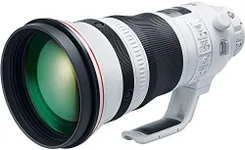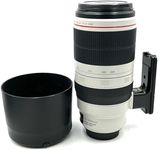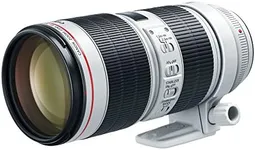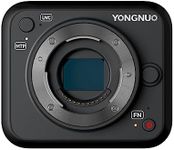Buying Guide for the Best Canon Telephoto Lens
Choosing the right Canon telephoto lens can significantly enhance your photography, especially when capturing distant subjects like wildlife, sports, or even portraits. Telephoto lenses allow you to zoom in on your subject while maintaining a good distance, providing a unique perspective and often a beautiful background blur. To make an informed decision, it's essential to understand the key specifications and how they align with your photography needs.Focal LengthThe focal length of a telephoto lens determines how much you can zoom in on your subject. It is usually measured in millimeters (mm). Shorter telephoto lenses (70-200mm) are versatile and great for portraits and events, while longer telephoto lenses (300mm and above) are ideal for wildlife and sports photography. Choose a focal length based on the distance you typically shoot from and the type of subjects you want to capture.
ApertureThe aperture of a lens, indicated by an f-number (e.g., f/2.8, f/4), controls the amount of light entering the lens and affects the depth of field. A lower f-number means a larger aperture, which allows more light and creates a shallower depth of field, resulting in a blurred background. This is particularly useful in low-light conditions and for isolating subjects. If you often shoot in varying light conditions or want more control over depth of field, opt for a lens with a wider maximum aperture (e.g., f/2.8).
Image StabilizationImage stabilization (IS) helps reduce camera shake, especially important when using long telephoto lenses where even small movements can cause blur. This feature is crucial for handheld shooting or in low-light situations. Lenses with built-in IS are beneficial if you frequently shoot without a tripod or in challenging conditions. Consider how often you shoot in such scenarios to determine if this feature is necessary for you.
Autofocus Speed and AccuracyAutofocus (AF) speed and accuracy are vital for capturing sharp images of moving subjects, such as in sports or wildlife photography. Lenses with advanced AF systems can quickly and accurately lock onto subjects, ensuring you don't miss critical moments. If you often photograph fast-moving subjects, prioritize lenses known for their fast and reliable autofocus performance.
Build Quality and Weather SealingThe build quality of a lens affects its durability and performance in various conditions. Weather-sealed lenses are designed to withstand dust, moisture, and harsh weather, making them ideal for outdoor and adventure photography. If you frequently shoot in challenging environments, investing in a robust, weather-sealed lens can ensure longevity and reliability.
Weight and SizeTelephoto lenses can be quite heavy and bulky, which can impact your comfort and mobility, especially during long shooting sessions. Consider the weight and size of the lens in relation to your shooting style and how often you travel with your gear. If you need a more portable setup, look for lenses that offer a good balance between performance and portability.
CompatibilityEnsure the telephoto lens you choose is compatible with your Canon camera body. Check the lens mount type (e.g., EF, EF-S, RF) and whether it supports full-frame or APS-C sensors. Compatibility is crucial for optimal performance and to avoid any issues with mounting or functionality.



















